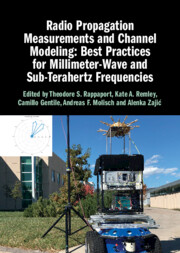Refine search
Actions for selected content:
1562 results in RF and microwave engineering
12 - Connection between the Measurements and Models
-
- Book:
- Radio Propagation Measurements and Channel Modeling: Best Practices for Millimeter-Wave and Sub-Terahertz Frequencies
- Published online:
- 18 August 2022
- Print publication:
- 25 August 2022, pp 259-280
-
- Chapter
- Export citation
Dedication
-
- Book:
- Radio Propagation Measurements and Channel Modeling: Best Practices for Millimeter-Wave and Sub-Terahertz Frequencies
- Published online:
- 18 August 2022
- Print publication:
- 25 August 2022, pp v-vi
-
- Chapter
- Export citation
9 - Peer-to-Peer Networking
-
- Book:
- Radio Propagation Measurements and Channel Modeling: Best Practices for Millimeter-Wave and Sub-Terahertz Frequencies
- Published online:
- 18 August 2022
- Print publication:
- 25 August 2022, pp 211-217
-
- Chapter
- Export citation
11 - Terahertz Channels
-
- Book:
- Radio Propagation Measurements and Channel Modeling: Best Practices for Millimeter-Wave and Sub-Terahertz Frequencies
- Published online:
- 18 August 2022
- Print publication:
- 25 August 2022, pp 232-258
-
- Chapter
- Export citation
1 - Introduction
-
- Book:
- Radio Propagation Measurements and Channel Modeling: Best Practices for Millimeter-Wave and Sub-Terahertz Frequencies
- Published online:
- 18 August 2022
- Print publication:
- 25 August 2022, pp 1-4
-
- Chapter
- Export citation
4 - Verification Techniques
-
- Book:
- Radio Propagation Measurements and Channel Modeling: Best Practices for Millimeter-Wave and Sub-Terahertz Frequencies
- Published online:
- 18 August 2022
- Print publication:
- 25 August 2022, pp 43-90
-
- Chapter
- Export citation
Index
-
- Book:
- Radio Propagation Measurements and Channel Modeling: Best Practices for Millimeter-Wave and Sub-Terahertz Frequencies
- Published online:
- 18 August 2022
- Print publication:
- 25 August 2022, pp 282-288
-
- Chapter
- Export citation
2 - Estimating Channel Characteristics from Measurements
-
- Book:
- Radio Propagation Measurements and Channel Modeling: Best Practices for Millimeter-Wave and Sub-Terahertz Frequencies
- Published online:
- 18 August 2022
- Print publication:
- 25 August 2022, pp 5-13
-
- Chapter
- Export citation
13 - Conclusions
-
- Book:
- Radio Propagation Measurements and Channel Modeling: Best Practices for Millimeter-Wave and Sub-Terahertz Frequencies
- Published online:
- 18 August 2022
- Print publication:
- 25 August 2022, pp 281-281
-
- Chapter
- Export citation

Radio Propagation Measurements and Channel Modeling: Best Practices for Millimeter-Wave and Sub-Terahertz Frequencies
-
- Published online:
- 18 August 2022
- Print publication:
- 25 August 2022
2 - Reconfigurable Devices and Smart Antennas
-
-
- Book:
- Reconfigurable Circuits and Technologies for Smart Millimeter-Wave Systems
- Published online:
- 20 May 2022
- Print publication:
- 26 May 2022, pp 43-107
-
- Chapter
- Export citation
1 - Introduction and Motivation
-
-
- Book:
- Reconfigurable Circuits and Technologies for Smart Millimeter-Wave Systems
- Published online:
- 20 May 2022
- Print publication:
- 26 May 2022, pp 1-42
-
- Chapter
- Export citation
Abbreviations
-
- Book:
- Reconfigurable Circuits and Technologies for Smart Millimeter-Wave Systems
- Published online:
- 20 May 2022
- Print publication:
- 26 May 2022, pp xii-xvi
-
- Chapter
- Export citation
Preface
-
- Book:
- Reconfigurable Circuits and Technologies for Smart Millimeter-Wave Systems
- Published online:
- 20 May 2022
- Print publication:
- 26 May 2022, pp ix-xi
-
- Chapter
- Export citation
Copyright page
-
- Book:
- Reconfigurable Circuits and Technologies for Smart Millimeter-Wave Systems
- Published online:
- 20 May 2022
- Print publication:
- 26 May 2022, pp iv-iv
-
- Chapter
- Export citation
Appendices
-
- Book:
- Reconfigurable Circuits and Technologies for Smart Millimeter-Wave Systems
- Published online:
- 20 May 2022
- Print publication:
- 26 May 2022, pp 415-435
-
- Chapter
- Export citation
3 - CMOS and BiCMOS Technologies
-
-
- Book:
- Reconfigurable Circuits and Technologies for Smart Millimeter-Wave Systems
- Published online:
- 20 May 2022
- Print publication:
- 26 May 2022, pp 108-200
-
- Chapter
- Export citation
Contents
-
- Book:
- Reconfigurable Circuits and Technologies for Smart Millimeter-Wave Systems
- Published online:
- 20 May 2022
- Print publication:
- 26 May 2022, pp v-v
-
- Chapter
- Export citation
Appendix 2 - Multiphysical Modeling of Nematic Liquid Crystals
-
- Book:
- Reconfigurable Circuits and Technologies for Smart Millimeter-Wave Systems
- Published online:
- 20 May 2022
- Print publication:
- 26 May 2022, pp 427-435
-
- Chapter
- Export citation
Appendix 1 - Satellite History, Orbits, and Classification
-
- Book:
- Reconfigurable Circuits and Technologies for Smart Millimeter-Wave Systems
- Published online:
- 20 May 2022
- Print publication:
- 26 May 2022, pp 415-426
-
- Chapter
- Export citation
